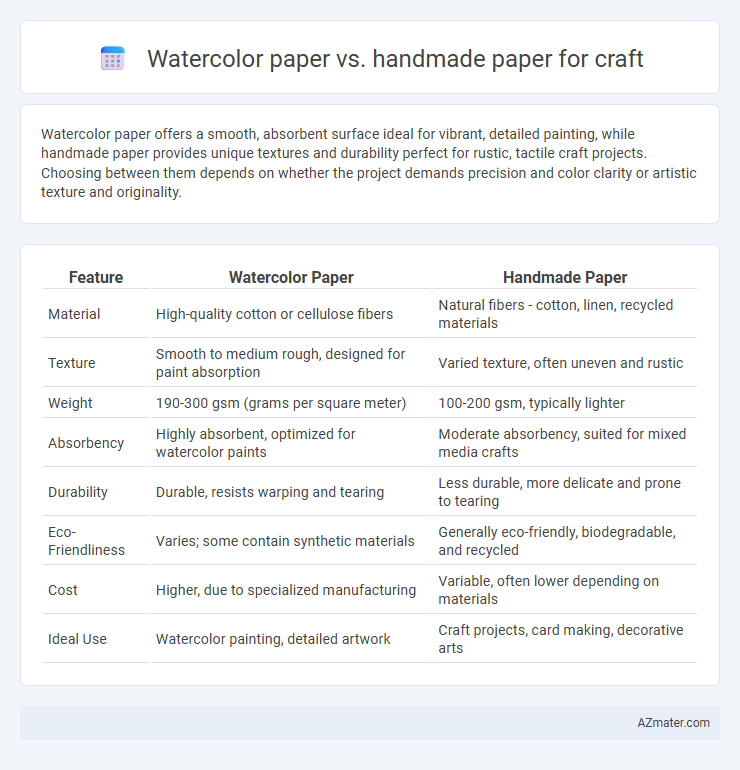Watercolor paper offers a smooth, absorbent surface ideal for vibrant, detailed painting, while handmade paper provides unique textures and durability perfect for rustic, tactile craft projects. Choosing between them depends on whether the project demands precision and color clarity or artistic texture and originality.
Table of Comparison
| Feature | Watercolor Paper | Handmade Paper |
|---|---|---|
| Material | High-quality cotton or cellulose fibers | Natural fibers - cotton, linen, recycled materials |
| Texture | Smooth to medium rough, designed for paint absorption | Varied texture, often uneven and rustic |
| Weight | 190-300 gsm (grams per square meter) | 100-200 gsm, typically lighter |
| Absorbency | Highly absorbent, optimized for watercolor paints | Moderate absorbency, suited for mixed media crafts |
| Durability | Durable, resists warping and tearing | Less durable, more delicate and prone to tearing |
| Eco-Friendliness | Varies; some contain synthetic materials | Generally eco-friendly, biodegradable, and recycled |
| Cost | Higher, due to specialized manufacturing | Variable, often lower depending on materials |
| Ideal Use | Watercolor painting, detailed artwork | Craft projects, card making, decorative arts |
Introduction to Watercolor and Handmade Paper
Watercolor paper is specifically designed to absorb and hold watercolor pigments without warping, featuring a textured surface made from high-quality cotton or cellulose fibers ideal for detailed and vibrant artwork. Handmade paper, crafted using traditional methods from natural fibers like cotton, hemp, or recycled materials, offers unique textures and irregularities that enhance the tactile and aesthetic appeal of craft projects. Both papers differ in durability, texture, and absorption, making selection crucial depending on the desired artistic effect and medium.
Defining Watercolor Paper: Types and Characteristics
Watercolor paper, designed specifically for wet media, comes primarily in three types: hot-pressed, cold-pressed, and rough, each offering distinct textures suitable for various painting techniques. Its composition typically includes 100% cotton or cellulose fibers, providing durability, excellent absorbency, and resistance to warping when wet. High-quality watercolor paper features a textured surface that enhances pigment retention and allows for vibrant color blending, making it essential for artists seeking precision and longevity in their artwork.
Understanding Handmade Paper: Features and Varieties
Handmade paper for crafts is distinguished by its textured surface, irregular edges, and natural fibers like cotton or recycled materials, offering unique tactile qualities compared to watercolor paper. Varieties include Lokta, Kozo, Mulberry, and Abaca, each known for durability, absorbency, and eco-friendly production methods that enhance artistic projects. Its organic composition allows for versatile use in mixed media, scrapbooking, and card-making, providing an artisanal aesthetic not typically achievable with machine-made watercolor paper.
Texture Comparison: Smoothness and Tooth
Watercolor paper offers a balanced texture with a slight tooth that enhances pigment absorption and control, ideal for detailed and fluid watercolor techniques. Handmade paper features more irregular textures and a pronounced roughness, providing a unique tactile quality that adds depth and character to craft projects. Smoothness in watercolor paper supports fine brushwork, while handmade paper's varied tooth emphasizes artistic expression and texture contrast in mixed media crafts.
Absorbency and Paint Handling
Watercolor paper is engineered for high absorbency, allowing watercolors to blend smoothly without warping, while handmade paper offers variable absorbency due to its unique fiber textures and thickness. Paint handling on watercolor paper ensures even pigment distribution and control, whereas handmade paper provides a textured surface that can create unpredictable effects and richer tactile responses. Artists often choose watercolor paper for precision and consistency and handmade paper for expressive, textured finishes in craft projects.
Durability and Longevity of Each Paper Type
Watercolor paper, typically made from high-quality cotton or cellulose fibers, offers exceptional durability and resistance to warping when exposed to water, making it ideal for long-lasting art projects. Handmade paper, often crafted from recycled textile fibers, varies in durability depending on the raw materials and production techniques but generally provides a unique texture with moderate longevity. For crafts requiring sustained structural integrity and moisture resistance, watercolor paper outperforms handmade paper in durability and archival quality.
Suitability for Different Craft Techniques
Watercolor paper offers a highly absorbent surface with a textured finish, making it ideal for techniques that require water control, such as wet-on-wet painting and layering washes. Handmade paper provides a unique, fibrous texture that suits mixed media crafts, calligraphy, and collage work, enhancing the tactile quality and visual depth. Both papers support different craft applications depending on the desired artistic effect and medium compatibility.
Cost and Accessibility Differences
Watercolor paper typically costs less and is widely available in various sizes at art supply stores and online, making it a budget-friendly option for craft projects. Handmade paper, while often more expensive due to artisanal production methods and limited availability, offers unique textures and eco-friendly qualities valued in specialized crafts. The cost difference is influenced by production scale and materials, with handmade paper being less accessible but preferred for high-end or bespoke craft designs.
Creative Outcomes: Which Paper Enhances Art?
Watercolor paper offers superior texture and absorbency, enabling vibrant color blending and detailed brushwork essential for dynamic artistic outcomes. Handmade paper, with its unique fibers and uneven surface, promotes creative experimentation and organic textures, enhancing artistic expression with a tactile, artisanal quality. Choosing between these papers depends on whether precision or texture-driven creativity is the priority for the craft.
Choosing the Right Paper for Your Craft Projects
Watercolor paper offers a textured surface and high absorbency, making it ideal for paint blending and detail work in craft projects. Handmade paper provides unique fibers and an artisanal feel, enhancing the aesthetic of collage, scrapbooking, and mixed media crafts. Choosing the right paper depends on the desired texture, durability, and project technique, with watercolor paper suited for wet media and handmade paper better for tactile and decorative uses.

Infographic: Watercolor paper vs Handmade paper for Craft
 azmater.com
azmater.com